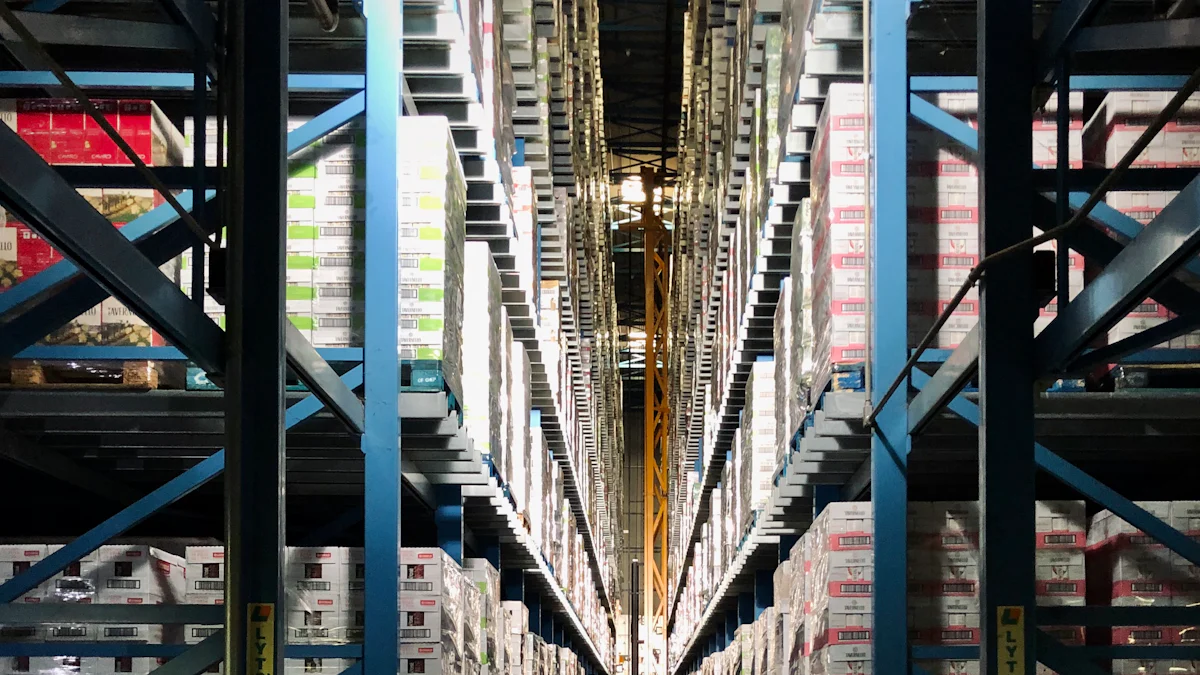How to Improve Supply Chain Visibility Using Big Data

Supply chain visibility holds paramount importance in today's competitive market. Companies with highly efficient supply chains experience better revenue growth, as highlighted by a Deloitte survey where 79% of such companies saw substantial improvements. Big data plays a crucial role in enhancing supply chain operations. Real-time tracking and monitoring of goods provide insights into shipment statuses, delivery routes, and logistics performance. Capgemini's study shows that real-time visibility reduces out-of-stock inventory by 50% and improves perfect order delivery by 10%. These advancements lead to streamlined operations and cost reductions.
Understanding Supply Chain Visibility
Definition and Importance
What is Supply Chain Visibility?
Supply chain visibility refers to the ability to track and monitor all aspects of the supply chain in real-time. This includes procurement, transportation, inventory, and exceptions. Companies can oversee the entire journey of goods from suppliers to customers. Real-time data provides insights into shipment statuses, delivery routes, and logistics performance.
Why is it Crucial for Businesses?
Supply chain visibility holds paramount importance for businesses. Real-time tracking reduces out-of-stock inventory by 50% and improves perfect order delivery by 10%, according to Capgemini. Enhanced visibility leads to streamlined operations and cost reductions. Companies with efficient supply chains experience better revenue growth. A Deloitte survey highlighted that 79% of such companies saw substantial improvements.
Current Challenges in Supply Chain Visibility
Lack of Real-Time Data
Many businesses struggle with the absence of real-time data. Without real-time updates, companies cannot make informed decisions. Delays in data lead to inefficiencies and increased costs. According to research, 94% of businesses do not have full visibility of their supply chain and logistics operations. This lack of visibility gradually eats into a business’ revenue, efficiency, productivity, and customer experience.
Fragmented Systems and Processes
Fragmented systems pose significant challenges. Different departments use various systems that do not communicate effectively. This fragmentation creates data silos, making it difficult to gain a comprehensive view of the supply chain. Manufacturers struggling to achieve supply chain visibility face significant challenges. The absence of visibility affects stakeholders, including analysts, managers, and C-Level executives.
Inefficient Communication Channels
Inefficient communication channels hinder supply chain visibility. Poor communication between suppliers, manufacturers, and distributors leads to delays and errors. Proactive sharing of updates with stakeholders is crucial. Frequent communication with suppliers helps maintain transparency and collaboration. Offering shipping tracking to customers enhances visibility by providing real-time information on the status of shipments.
The Role of Big Data in Supply Chain Visibility

Introduction to Big Data
Definition and Characteristics of Big Data
Big data refers to large volumes of data generated at high velocity and in various formats. This data includes structured, semi-structured, and unstructured data. The three main characteristics of big data are volume, velocity, and variety. Volume refers to the vast amounts of data generated every second. Velocity indicates the speed at which data is generated and processed. Variety encompasses the different types of data, such as text, images, and videos.
How Big Data Differs from Traditional Data
Big data differs from traditional data in several ways. Traditional data usually involves smaller datasets that are structured and stored in relational databases. Big data includes massive datasets that require specialized tools for processing and analysis. Traditional data analysis focuses on historical data, while big data enables real-time analysis. The ability to analyze data in real-time provides significant advantages for businesses.
Capabilities of Big Data in Supply Chain Management
Real-Time Data Collection and Analysis
Big data enhances supply chain visibility through real-time data collection and analysis. Sensors and IoT devices collect data from various points in the supply chain. This data includes information on inventory levels, shipment statuses, and transportation routes. Real-time data allows businesses to monitor their supply chains continuously. This continuous monitoring helps identify issues promptly and take corrective actions.
Predictive Analytics and Forecasting
Big data enables predictive analytics and forecasting in supply chain management. Predictive analytics uses historical data to predict future events. Businesses can forecast demand, optimize inventory levels, and plan production schedules. Accurate forecasting reduces the risk of stockouts and overstock situations. This capability improves overall supply chain visibility and efficiency.
Enhanced Decision-Making Processes
Big data improves decision-making processes in supply chain management. Advanced analytics tools analyze data to provide actionable insights. These insights help managers make informed decisions quickly. Improved decision-making leads to better resource allocation and cost savings. Enhanced supply chain visibility ensures that all stakeholders have access to the same information. This transparency fosters collaboration and improves overall supply chain performance.
Benefits of Improved Supply Chain Visibility Using Big Data
Operational Efficiency
Streamlined Processes
Big data analytics revolutionizes supply chain visibility by streamlining processes. Companies can monitor real-time data from various touchpoints within the supply chain. This continuous monitoring allows for immediate adjustments and optimizations. For instance, businesses can reroute shipments to avoid delays. This proactive approach minimizes disruptions and enhances overall efficiency.
Reduced Operational Costs
Enhanced supply chain visibility through big data leads to significant cost reductions. Accurate demand forecasting reduces inventory holding costs by up to 20%. Optimized inventory levels prevent overstocking and stockouts. Efficient route planning lowers transportation expenses. These improvements collectively reduce operational costs and increase profitability.
Risk Management
Proactive Issue Identification
Big data enables proactive issue identification in supply chain management. Predictive analytics helps identify potential bottlenecks and risks. Early detection allows businesses to take preventative actions. For example, companies can address supplier delays before they impact production. This proactive stance mitigates risks and ensures smooth operations.
Improved Contingency Planning
Improved supply chain visibility enhances contingency planning. Big data provides insights into potential disruptions and their impacts. Businesses can develop robust contingency plans to address these scenarios. Effective contingency planning minimizes downtime and maintains service levels. This preparedness strengthens the overall resilience of the supply chain.
Customer Satisfaction
Faster Delivery Times
Enhanced supply chain visibility results in faster delivery times. Real-time tracking allows businesses to monitor shipments continuously. Companies can optimize delivery routes and schedules based on real-time data. This optimization reduces transit times and ensures timely deliveries. Faster delivery times improve customer satisfaction and loyalty.
Enhanced Product Tracking
Big data improves product tracking capabilities within the supply chain. Real-time monitoring provides customers with accurate updates on their orders. Enhanced tracking builds trust and transparency with customers. This transparency leads to a better customer experience. Customers appreciate knowing the exact status of their shipments.
Methods to Improve Supply Chain Visibility with Big Data
Implementing Advanced Analytics Tools
Choosing the Right Tools
Businesses must select the appropriate tools to enhance supply chain visibility. Advanced analytics tools process both structured and unstructured data. These tools provide timely alerts, enabling optimal decision-making. Companies should consider tools that offer predictive analytics, AI, and location intelligence. These features help monitor warehouse activities, partner responses, and customer needs.
Integration with Existing Systems
Integration with existing systems is crucial for effective supply chain visibility. Businesses should ensure that new analytics tools communicate seamlessly with current systems. This integration prevents data silos and promotes a unified view of the supply chain. Companies can achieve end-to-end visibility, enhancing operational efficiency and decision-making processes.
Leveraging IoT and Sensor Technologies
Real-Time Tracking and Monitoring
IoT and sensor technologies play a vital role in supply chain visibility. These technologies enable real-time tracking and monitoring of goods. Sensors collect data on inventory levels, shipment statuses, and transportation routes. Real-time monitoring helps businesses identify issues promptly and take corrective actions. This proactive approach minimizes disruptions and enhances overall efficiency.
Data Collection from Multiple Sources
Data collection from multiple sources enriches supply chain visibility. IoT devices gather data from various points within the supply chain. This data includes information from suppliers, manufacturers, and distributors. Comprehensive data collection provides a holistic view of the supply chain. Businesses can make informed decisions based on accurate and up-to-date information.
Building a Data-Driven Culture
Training and Development
Training and development are essential for fostering a data-driven culture. Employees must understand the importance of supply chain visibility and how to utilize big data tools. Training programs should focus on data analysis, interpretation, and application. Continuous development ensures that employees stay updated with the latest technologies and best practices.
Encouraging Data-Driven Decision Making
Encouraging data-driven decision-making enhances supply chain visibility. Businesses should promote a culture where decisions are based on data insights. Managers and employees must rely on data to guide their actions. This approach leads to better resource allocation, cost savings, and improved supply chain performance. Transparency and collaboration among stakeholders further strengthen the supply chain.
Case Studies and Practical Examples

Successful Implementations
Company A: Improved Efficiency and Cost Reduction
Amazon has successfully leveraged Big Data to enhance supply chain visibility. The company uses data analytics to optimize its fulfillment centers. Real-time data collection and analysis enable Amazon to monitor inventory levels and shipment statuses continuously. This approach helps Amazon reroute shipments to avoid delays, reducing operational costs. The company has achieved significant improvements in efficiency and cost reduction through advanced analytics tools.
Company B: Enhanced Customer Satisfaction
Walmart has also embraced Big Data to improve supply chain visibility. Walmart uses data analytics to enhance inventory management. Real-time tracking allows Walmart to monitor stock levels and predict demand accurately. This capability ensures that products are always available for customers, leading to faster delivery times. Enhanced product tracking builds trust and transparency with customers, resulting in higher customer satisfaction.
Lessons Learned
Common Pitfalls to Avoid
Companies must avoid several common pitfalls when implementing Big Data solutions for supply chain visibility:
Data Silos: Fragmented systems create data silos, making it difficult to gain a comprehensive view of the supply chain. Integration with existing systems is crucial.
Lack of Real-Time Data: Without real-time updates, companies cannot make informed decisions. Delays in data lead to inefficiencies and increased costs.
Poor Communication: Inefficient communication channels hinder supply chain visibility. Proactive sharing of updates with stakeholders is essential.
Best Practices for Implementation
Several best practices can help companies successfully implement Big Data solutions for supply chain visibility:
Choose the Right Tools: Select advanced analytics tools that process both structured and unstructured data. Consider tools that offer predictive analytics, AI, and location intelligence.
Integrate with Existing Systems: Ensure that new analytics tools communicate seamlessly with current systems. This integration promotes a unified view of the supply chain.
Leverage IoT and Sensor Technologies: Use IoT devices to collect data from various points within the supply chain. Real-time tracking and monitoring enhance overall efficiency.
Build a Data-Driven Culture: Train employees on the importance of supply chain visibility and how to utilize Big Data tools. Encourage data-driven decision-making to improve resource allocation and cost savings.
Supply chain visibility remains crucial for businesses seeking operational efficiency and customer satisfaction. Big data provides the tools necessary to achieve this visibility. Companies must adopt big data solutions to enhance their supply chain management. These solutions offer real-time insights, predictive analytics, and improved decision-making capabilities. The future of supply chain visibility will continue to evolve with advancements in big data technologies. Businesses that embrace these innovations will gain a competitive edge and drive growth.
See Also
Unveiling Big Data's Influence on Supply Chain Enhancement
Transforming Supply Chains through Machine Learning Data Insights
The Crucial Role of Visibility in Optimizing Supply Chains
Optimizing Efficiency with JUSDA's Comprehensive Supply Chain View
